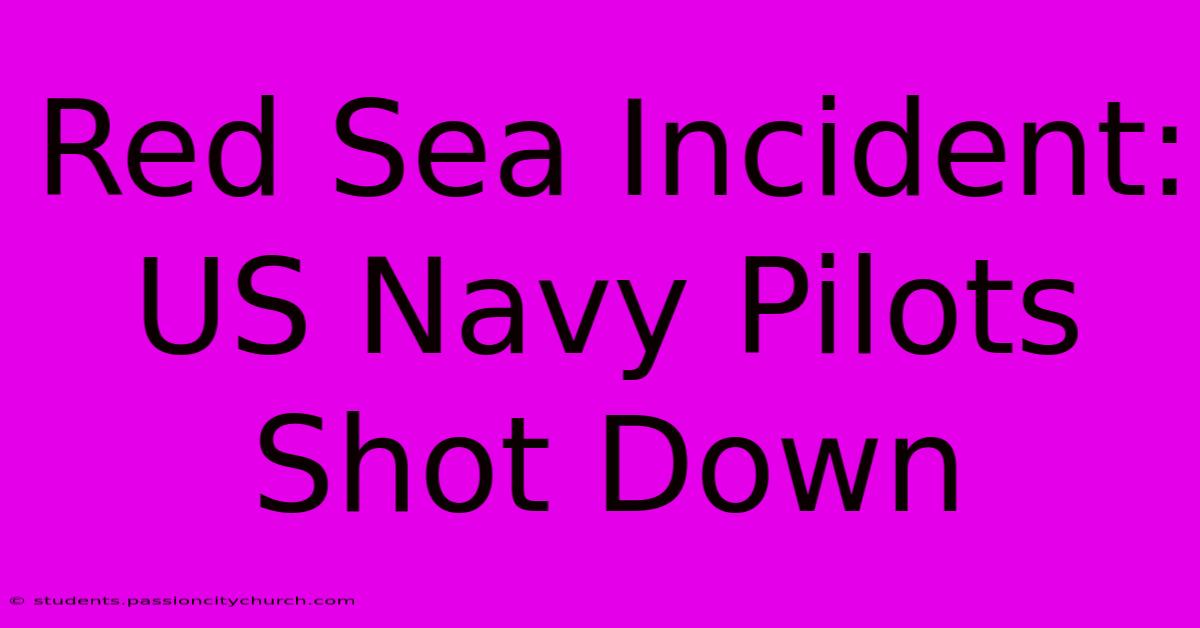Red Sea Incident: US Navy Pilots Shot Down

Discover more detailed and exciting information on our website. Click the link below to start your adventure: Visit Best Website. Don't miss out!
Table of Contents
Red Sea Incident: US Navy Pilots Shot Down – Unraveling the Mystery
The Red Sea, a narrow waterway connecting the Indian Ocean to the Mediterranean, has witnessed its share of historical conflict. However, one incident remains shrouded in controversy and speculation: the alleged shooting down of US Navy pilots over the Red Sea. While no single, definitively documented event fits this precise description, several incidents involving US Navy aircraft in the Red Sea region have fueled this persistent narrative, often conflated and exaggerated online. This article will delve into these events, separating fact from fiction, and exploring the complexities surrounding potential hostile actions against US Navy aircraft in the area.
The Lack of a Singular "Red Sea Incident"
The challenge in addressing this topic lies in the lack of a single, universally acknowledged "Red Sea Incident" where US Navy pilots were definitively shot down. Instead, the term encompasses various incidents, some documented, others relegated to rumor and speculation, all sharing a common thread: US Navy aircraft operating near the Red Sea facing potential or actual hostile actions. These incidents often involve different time periods, actors, and circumstances, making it crucial to examine them individually to understand the complexities.
Potential Contributing Factors and Related Incidents:
Several factors could contribute to the narrative of US Navy pilots being shot down over the Red Sea, even if no confirmed incidents perfectly fit the description:
-
Regional Instability: The Red Sea region has long been a volatile area, with ongoing conflicts and political tensions involving multiple countries. This instability increases the risk of misidentification, accidental engagements, and potential hostile actions against aircraft, regardless of nationality.
-
Proliferation of Air Defenses: The region has seen a significant increase in sophisticated air defense systems over the decades. These systems, operated by various actors, could potentially pose a threat to low-flying aircraft, leading to misidentification and accidental engagements.
-
Cold War Tensions: During the Cold War, proxy conflicts and heightened tensions between the US and the Soviet Union (and their respective allies) in the region increased the probability of incidents involving US military aircraft. While not directly resulting in confirmed shootdowns, close calls and near misses likely fuelled speculation.
-
Misidentification and Accidental Engagements: Mistaken identity remains a significant risk in any military operation. Poor communication, limited visibility, and the use of similar aircraft by various actors can lead to accidental engagements, where aircraft are mistakenly targeted.
-
Targeted Attacks (Allegations): While no widely accepted evidence supports claims of deliberate attacks leading to US Navy pilot deaths, allegations persist. These claims often lack sufficient corroboration and are frequently spread through unofficial channels, making verification challenging.
Examining Potential Incidents (with Cautions):
While no definitive "Red Sea Incident" exists in the way the phrase is often used, we can examine potential events that may have contributed to the narrative:
-
Incidents during the Yemen Civil War: The ongoing conflict in Yemen has seen significant air activity, with both government and rebel forces utilizing air defenses. While numerous incidents involving coalition aircraft have been reported, confirming any specific shootdown of US Navy aircraft requires rigorous verification from credible sources.
-
Incidents related to counter-terrorism operations: US military operations targeting terrorist groups in the region could lead to confrontations with various actors, including accidental engagements or targeted attacks. However, confirmed details regarding such incidents are usually classified for national security reasons.
-
Older, less documented incidents: Throughout the history of US naval operations in the Red Sea, various incidents involving aircraft may have been downplayed or remained undocumented, contributing to the enduring myth of shootdowns.
The Importance of Critical Analysis and Fact-Checking:
The proliferation of misinformation online necessitates a critical approach to examining narratives like the "Red Sea Incident." Relying solely on unsubstantiated claims or anecdotal evidence leads to inaccuracies and the perpetuation of myths. Reliable information sources, including official government statements, credible news organizations, and academic research, are essential to separating fact from fiction.
Conclusion:
The narrative of US Navy pilots being shot down in the Red Sea requires careful examination. While no single, confirmed incident precisely matches this description, numerous incidents involving US Navy aircraft in the region have contributed to the persistent myth. Regional instability, advancements in air defense systems, and the potential for misidentification all create scenarios where such an event could theoretically occur. However, the absence of widely accepted, corroborated evidence regarding a specific shootdown underlines the importance of relying on verified information and critical analysis when navigating complex geopolitical events. Further research, access to classified information, and rigorous fact-checking are crucial to fully understanding the historical reality of US naval operations in the Red Sea.

Thank you for visiting our website wich cover about Red Sea Incident: US Navy Pilots Shot Down. We hope the information provided has been useful to you. Feel free to contact us if you have any questions or need further assistance. See you next time and dont miss to bookmark.
Also read the following articles
| Article Title | Date |
|---|---|
| Penn State Volleyball Ncaa Champs | Dec 23, 2024 |
| Penn State Wins 8th Ncaa Volleyball Title | Dec 23, 2024 |
| Real Madrid Vs Sevilla Minuto A Minuto | Dec 23, 2024 |
| Wolfsburg Sieg Bvb Beendet Auswaertsmisere | Dec 23, 2024 |
| Nfl Recap 29 17 Win Over 49ers | Dec 23, 2024 |
| Suid Afrika Aardbewing In Kaapstad Gevoel | Dec 23, 2024 |
| Monza Juventus Thiago Motta Tanpa 6 Inti | Dec 23, 2024 |
| Manchester United Bournemouth Live Match Updates | Dec 23, 2024 |
| Everton Derrota Chelsea United Tambem Perde | Dec 23, 2024 |
| Competitive Patriots Game Eight Observations | Dec 23, 2024 |
